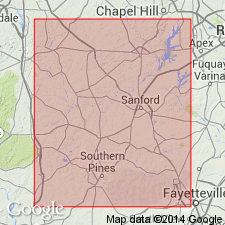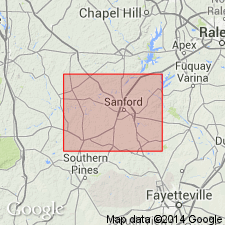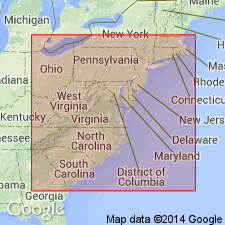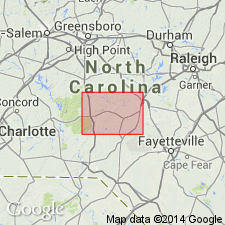
- Usage in publication:
-
- Pekin formation
- Modifications:
-
- Named
- Dominant lithology:
-
- Sandstone
- Shale
- Conglomerate
- AAPG geologic province:
-
- Piedmont-Blue Ridge province
Summary:
The "lower red sandstone" of Emmons (1857) is here named the Pekin formation of the Newark group for exposures near Pekin, NC. It consists of red and brown sandstone, shale, and conglomerate. The "millstone grit", a basal hard gray conglomerate, unconformably overlies older metamorphic rocks. The Pekin gradationally underlies the Cumnock formation. Outcrops are in a belt along the northwest side of the Triassic basins. Thickness ranges from 1,000 to 2,000 ft.
Source: GNU records (USGS DDS-6; Reston GNULEX).

- Usage in publication:
-
- Pekin formation*
- Modifications:
-
- Overview
- AAPG geologic province:
-
- Piedmont-Blue Ridge province
Summary:
Pekin formation of the Newark group is adopted by the USGS. Contacts between the Pekin and the overlying Cumnock are gradational and arbitrary in some places. In general, the top of the Pekin is drawn at the top of the highest persistent red or brown beds below the coal beds.
Source: GNU records (USGS DDS-6; Reston GNULEX).

- Usage in publication:
-
- Pekin Formation
- Modifications:
-
- Age modified
- Biostratigraphic dating
- AAPG geologic province:
-
- Piedmont-Blue Ridge province
Summary:
Palynoflora high in the section of the Pekin Formation at the type locality at Pekin, North Carolina, in the Wadesboro basin, are more consistent with flora of the Cumnock Formation, which overlies the Pekin farther north but is not recognizable on lithologic grounds in the Wadesboro basin. It is possible that the type locality of the Pekin may be as young or younger than the Cumnock (late middle Carnian).
Source: GNU records (USGS DDS-6; Reston GNULEX).

- Usage in publication:
-
- Pekin Formation
- Modifications:
-
- Revised
- AAPG geologic province:
-
- Piedmont-Blue Ridge province
Summary:
The Pekin Formation is here assigned to the Chatham Group of the Newark Supergroup in the Wadesboro, Sanford, and Durham basins, NC.
Source: GNU records (USGS DDS-6; Reston GNULEX).

- Usage in publication:
-
- Pekin Formation*
- Modifications:
-
- Age modified
- Biostratigraphic dating
- AAPG geologic province:
-
- Piedmont-Blue Ridge province
Summary:
This report revises the ages of the Chatham Group rocks. Late Carnian palynomorphs in Wadesboro subbasin attributed to the type Pekin Formation (lowest of the Chatham Group) extend the age of the Pekin into the late Carnian. Late Carnian palynomorphs were also identified in the Cumnock Formation in the Sanford subbasin, thus confirming the age of the Cumnock. Plant megafossil and fossil vertebrate data from rocks in the Sanford subbasin also support these ages. Although the Sanford Formation has not been dated paleontologically, it must extend into the lower Norian on the basis of lithologic correlation with the Stoneville Formation of the Danville-Dan River basin 100 km to the northeast. The upper part of the Stoneville contains early Norian palynomorphs. This evidence indicates that Chatham Group sediments were deposited from the early(?) Carnian through the early Norian, a much longer interval than previously thought.
Source: GNU records (USGS DDS-6; Reston GNULEX).
For more information, please contact Nancy Stamm, Geologic Names Committee Secretary.
Asterisk (*) indicates published by U.S. Geological Survey authors.
"No current usage" (†) implies that a name has been abandoned or has fallen into disuse. Former usage and, if known, replacement name given in parentheses ( ).
Slash (/) indicates name conflicts with nomenclatural guidelines (CSN, 1933; ACSN, 1961, 1970; NACSN, 1983, 2005, 2021). May be explained within brackets ([ ]).

